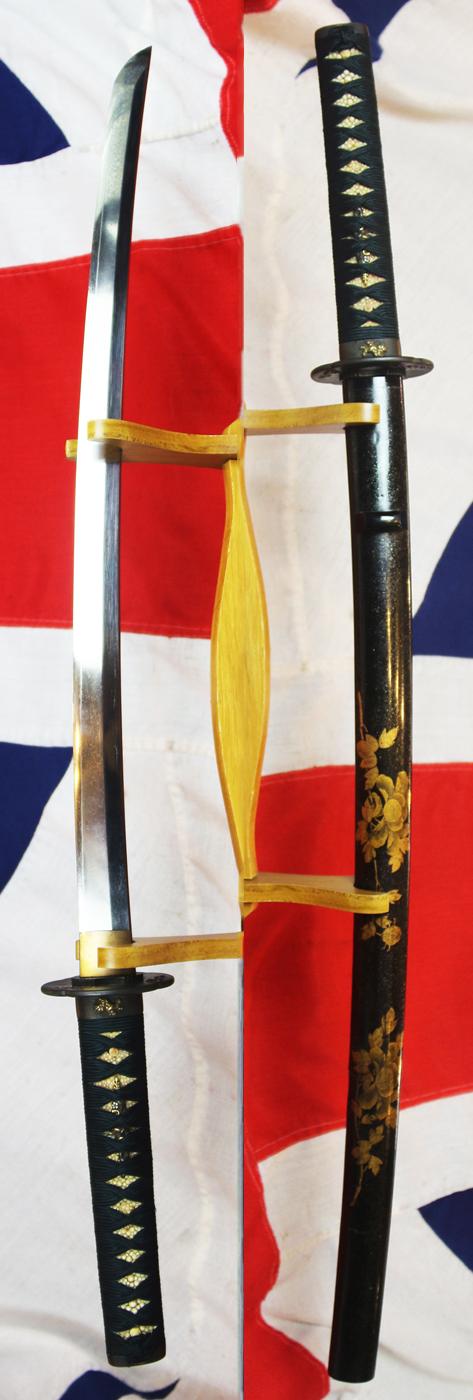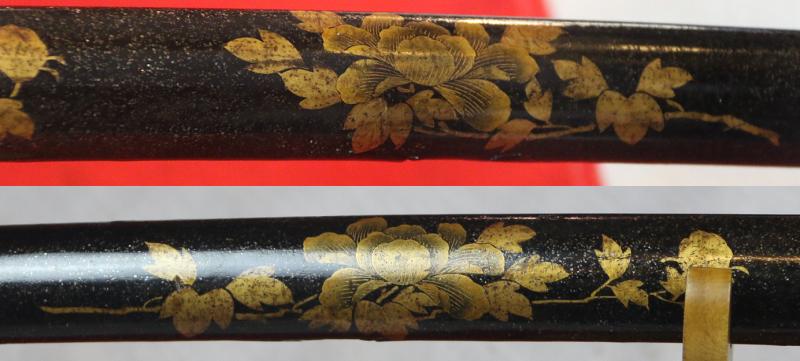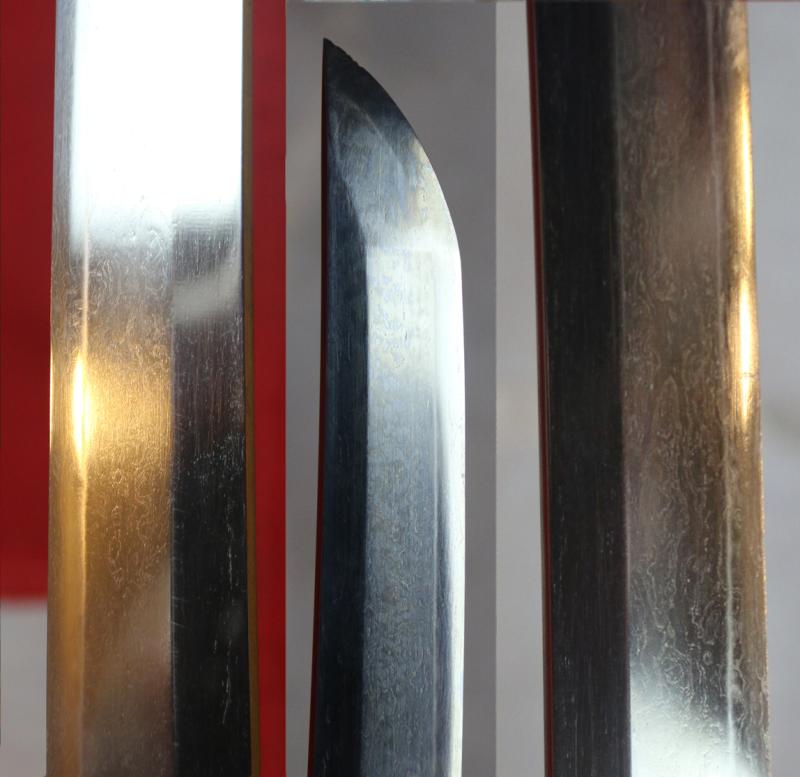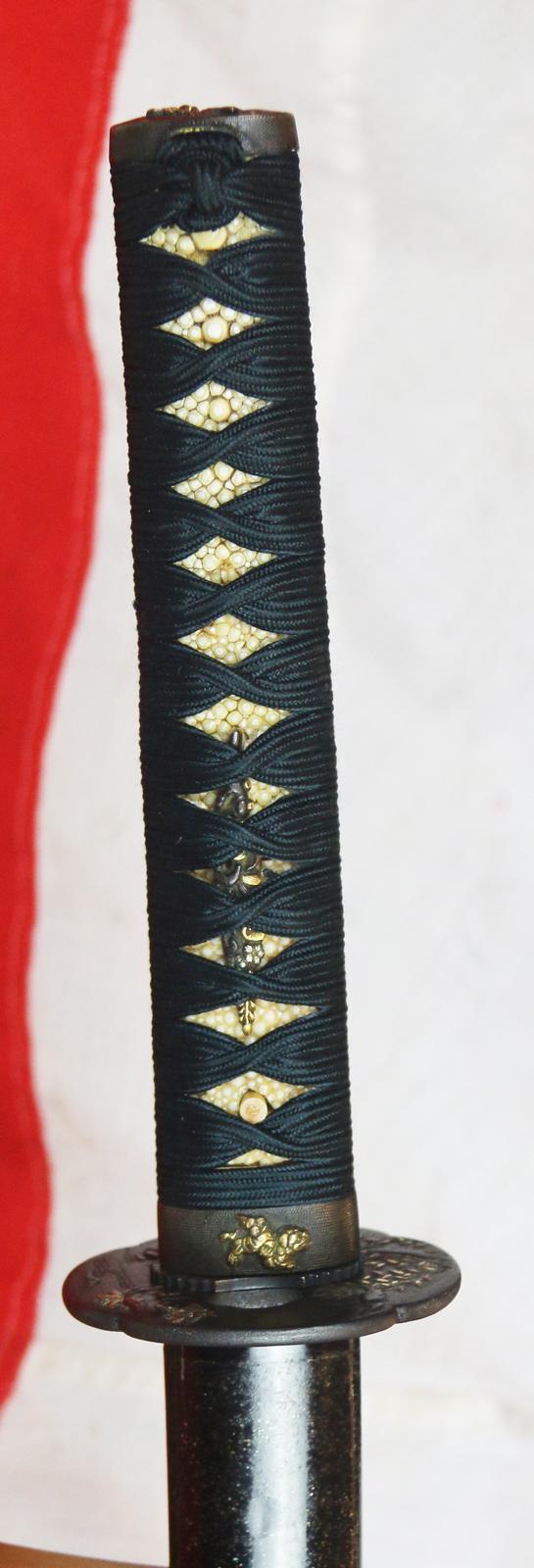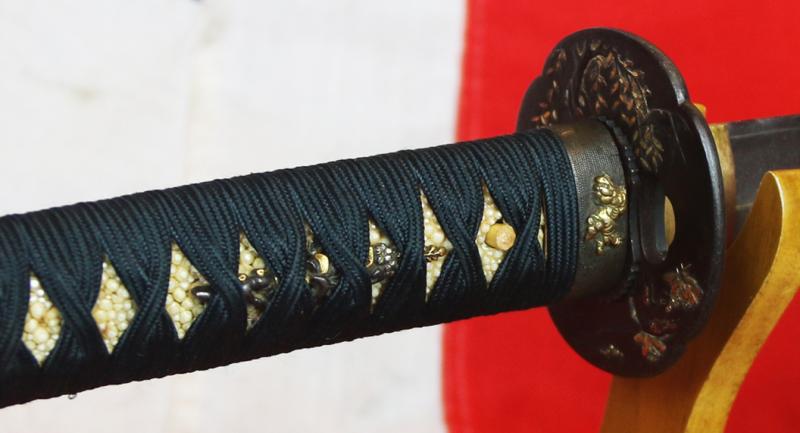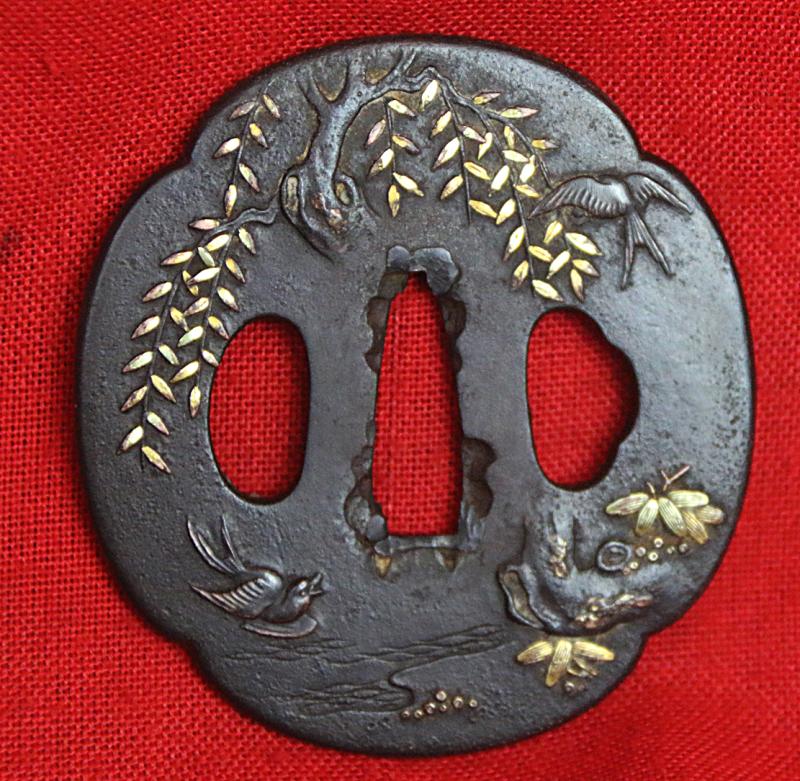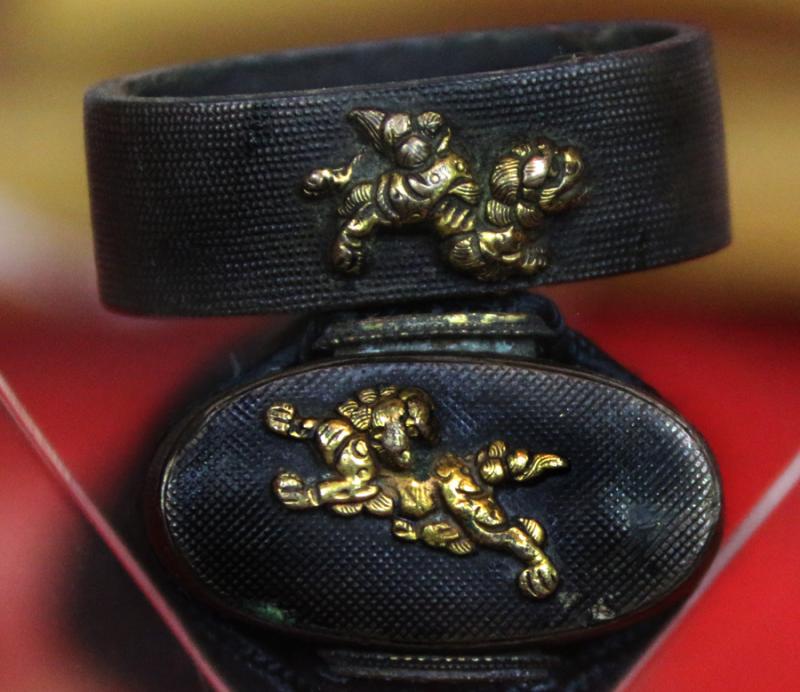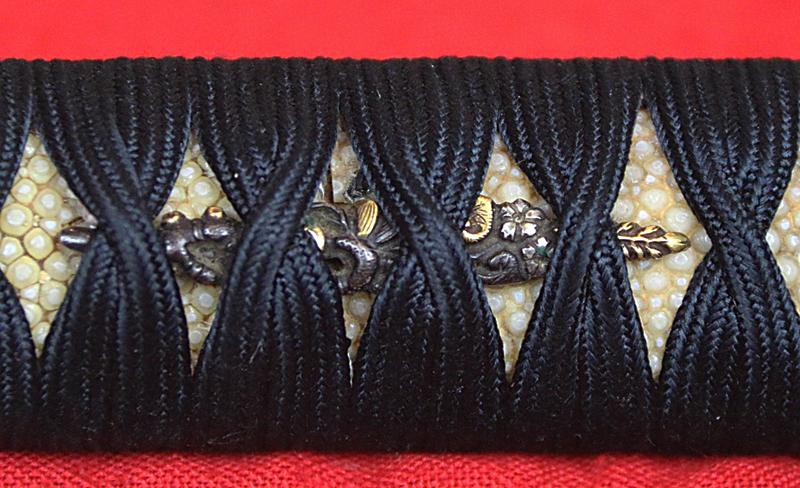A Stunning Edo Period Chisa Katana, Art Sword With A Most Beautiful Original Edo Saya Decor of Gold Nishiji Lacquer Flowers Over An Abilone Shell Infused Black Urushi Lacquer Ground. The Blade With Suguha Hamon And Wonderful Hada Grain.
This is a most impressive sword of superb elegance with all original Edo koshirae fittings and mounts that compliment each other beautifully.
The tettsu plate tsuba has takebori multi coloured gold leaves tumbling down the branches of a weeping willow, with a pair of swallows in flight swooping above a rolling river. The fuchi kashira are takebori shi-shi lion dogs in gold on a Nanako ground. Shakudo and gold menuki over black tsukaito.
The blade is late Koto to early Shinto, and shows a most attractive and impressive grain, almost a blending of two styles, the Mokume Hada, this is based on Itame hada using a different hammer blow to produce whorls yet it also verges on a Shitahara Hada. A Shitahara-hada shows conspicious uzumaki burls along the centre of the blade, i.e. along the shinogi-ji or the center of the ji if in hira-zukuri. But these burls might also appear more towards the ha or in an irregular manner, that means as isolated large burls in places.
However, in truth, it takes about 10 to 15 times fold depending on the methods used by the swordsmith. With every fold, the strength of the sword increases.
The gold flower lacquer decor on the saya has very elegant black pen-work defining upon every leaf and flower. The result of such fine and technical craftsmanship is incredibly pleasing to the eye. With the finest abilone infused black urushi beneath and clear urushi upon the outer whole, it is a saya of incredible beauty.
Japanese lacquer, or urushi, is a transformative and highly prized material that has been refined for over 7000 years.
Cherished for its infinite versatility, urushi is a distinctive art form that has spread across all facets of Japanese culture from the tea ceremony to the saya scabbards of samurai swords
Japanese artists created their own style and perfected the art of decorated lacquerware during the 8th century. Japanese lacquer skills reached its peak as early as the twelfth century, at the end of the Heian period (794-1185). This skill was passed on from father to son and from master to apprentice.
Some provinces of Japan were famous for their contribution to this art: the province of Edo (later Tokyo), for example, produced the most beautiful lacquered pieces from the 17th to the 18th centuries. Lords and shoguns privately employed lacquerers to produce ceremonial and decorative objects for their homes and palaces.
The varnish used in Japanese lacquer is made from the sap of the urushi tree, also known as the lacquer tree or the Japanese varnish tree (Rhus vernacifera), which mainly grows in Japan and China, as well as Southeast Asia. Japanese lacquer, 漆 urushi, is made from the sap of the lacquer tree. The tree must be tapped carefully, as in its raw form the liquid is poisonous to the touch, and even breathing in the fumes can be dangerous. But people in Japan have been working with this material for many millennia, so there has been time to refine the technique!
Flowing from incisions made in the bark, the sap, or raw lacquer is a viscous greyish-white juice. The harvesting of the resin can only be done in very small quantities.
Three to five years after being harvested, the resin is treated to make an extremely resistant, honey-textured lacquer. After filtering, homogenization and dehydration, the sap becomes transparent and can be tinted in black, red, yellow, green or brown.
Once applied on an object, lacquer is dried under very precise conditions: a temperature between 25 and 30°C and a humidity level between 75 and 80%. Its harvesting and highly technical processing make urushi an expensive raw material applied in exceptionally fine successive layers, on objects such as bowls or boxes.After heating and filtering, urushi can be applied directly to a solid, usually wooden, base. Pure urushi dries into a transparent film, while the more familiar black and red colours are created by adding minerals to the material. Each layer is left to dry and polished before the next layer is added. This process can be very time-consuming and labor-intensive, which contributes to the desirability, and high costs, of traditionally made lacquer goods. The skills and techniques of Japanese lacquer have been passed down through the generations for many centuries. For four hundred years, the master artisans of Zohiko’s Kyoto workshop have provided refined lacquer articles for the imperial household
Nanako Ji: "fish roe ground" A surface decoration on the swords fuchi kashira are produced by forming very small raised bosses by a sharply struck punch or burin called 'nanako tagane'. Shakudo is the metal most often used, but copper and gold are quite often employed. The harder metals, shibuichi, silver and iron are rarely decorated in this way. The size of the dots vary from 0.04" to 0.008" (25 to 125 and inch) and the regularity of the work is marvelous as the dots must be spaced entirely by touch. The dots are usually arranged in straight lines or in lines parallel to the edge of the piece being decorated, but sometimes in more elaborate patterns. Used on guards since the Momoyama period although the technique existed since much earlier periods. Usually done by specialist 'nanako-shi', but sometimes done by the maker of the guard himself
A katana was two shaku or longer in length (one shaku = about 11.93 inches). However, the Chisa katana is longer than the wakizashi, which was somewhere in between one and two shaku in length. The most common blade lengths for Chisa katana was approximately eighteen to twenty-four inches. They were most commonly made in the Buke-Zukuri mounting (which is generally what is seen on katana and wakizashi). The chisa katana was able to be used with one or even two hands like a katana. The Chisa Katana is a slightly shorter Katana highly suitable for two handed, or two sword combat, or, combat within enclosed areas such as castles or buildings. As such they were often the sword of choice for the personal Samurai guard of a Daimyo, and generally the only warriors permitted to be armed in his presence. Chisa katana, Chiisagatana or literally "short katana", are shoto mounted as katana.
The chisa katana was also the long sword of choice for the art of twin sword combat, using two at once in unison, a chisa katana and wakazashi, one in each hand, a form used by the great and legendary samurai Miyamoto Musashi who reportedly killed 60 men before his 30th birthday.
Miyamoto Musashi 1584 – June 13, 1645), also known as Shinmen Takezo, Miyamoto Bennosuke or, by his Buddhist name, Niten Doraku, was an expert Japanese swordsman and ronin. Musashi, as he was often simply known, became renowned through stories of his excellent, and unique double bladed swordsmanship and undefeated record in his 60 duels. He was the founder of the Hyoho Niten Ichi-ryu or Niten-ryu style of swordsmanship and in his final years authored the The Book of Five Rings, a book on strategy, tactics, and philosophy that is still studied today.
The blade is in old polish and superb condition for age with the tiniest of near invisible edge marks at the kissaki. The lacquer saya is also in fabulous condition for age with just very small surface losses in one area.
Every single item from The Lanes Armoury is accompanied by our unique Certificate of Authenticity. Part of our continued dedication to maintain the standards forged by us over the past 100 years of our family’s trading, as Britain’s oldest established, and favourite, armoury and gallery
Code: 25316

